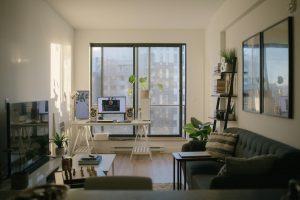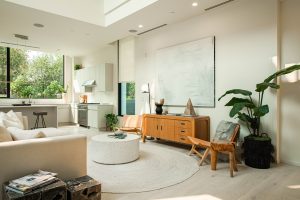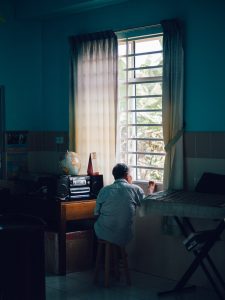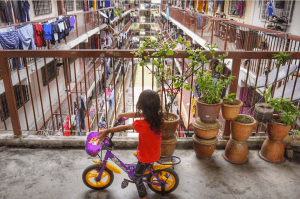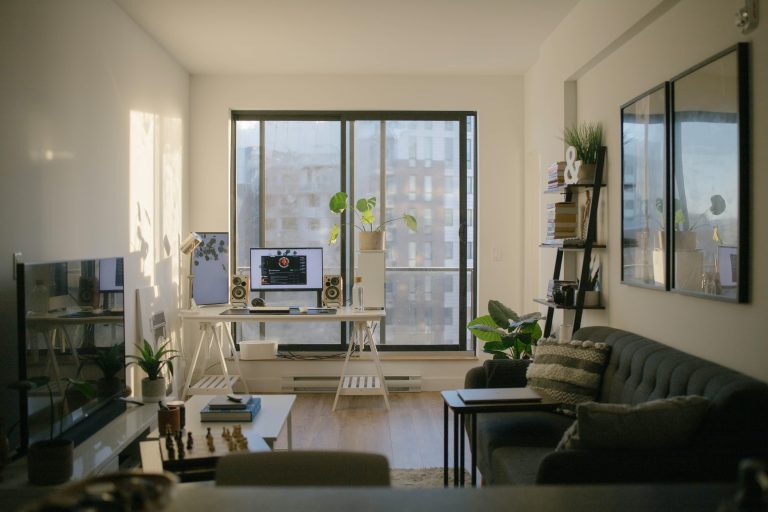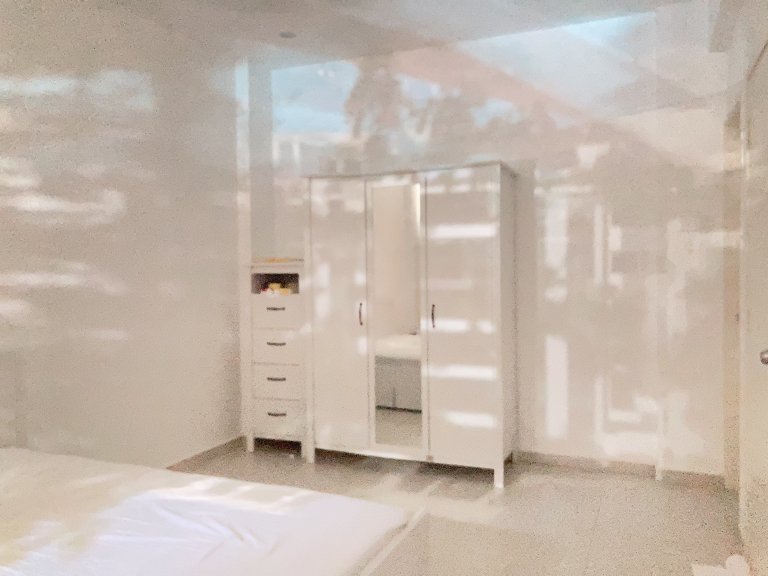Article
COMFORT (and the lack of it) FOR THE URBAN POOR DURING PANDEMIC
On the 25th of January 2020, the first case of COVID-19 was detected in Malaysia by three Chinese nationals who have been in close contact with a positive COVID-19 patient in Singapore [1]“[Breaking] 3 coronavirus cases confirmed in Johor Baru,” New Straits Time, 2020.
. Since then, several phases of full or partial lockdown and Movement Control Order (MCO) have been implemented by the Malaysian government. As the COVID-19 pandemic to stay at home or spend a considerable amount of time at home, the home-living condition needs to be in a state that provides comfort to the occupants. Therefore, a home is now considered an all-in-one place that fits all activities performed indoors: a place designated as workspace, study area, child daycare, gym, entertainment centre (or lack thereof) and many more.
All-in-one room : A home is now considered an all-in-one place that fits all activities performed indoors: a place designated as workspace, study area, child daycare, gym, entertainment centre (or lack thereof) and many more.
The term ‘comfort’ can be applied to describe the physical, psychological and emotional condition. Based on Oxford’s English dictionary, comfort is the term that refers to either “a state of physical ease and freedom from pain or constraint” or “the easing or alleviation of a person’s feelings of grief or distress”. Factors that make someone feel or are in a state of comfort vary, but most can be seen as contributed by external or internal factors. Comfort can also be seen as a cognitive-behavioural process, which involves the concepts of having a sense of control, habits, and emotions.
Generally, people will do almost anything to make themselves feel comfortable. However their perception and expectation of a comfortable living space vary, from anything that involves a physical setup to a surrounding that impacts their emotional or mental wellbeing. These perceptions and expectations are influenced by past habits, attitude, and adaptive behaviour, which allow occupants to be able to adapt to a variety of indoor conditions. However, if a change occurs that contribute uncomfortable living conditions, the occupants will behave in ways that tend to restore their comfort or minimise discomfort. If comfort is not achieved to the acceptable level, the occupants’ physical, emotional, and mental wellbeing can become compromised.
This action or behaviour whereby the occupants constantly devise ways to modify their behaviour or alter their surroundings to create a comfortable living space is defined as comfort behaviour. It’s a behaviour associated with the needs to have a comfort state of feeling or physical condition that pushes individuals to act in a certain manner in order to achieve the desired comfort level.
This article will look at how comfort can be achieved through the four aspects of Indoor Environment Quality (IEQ) [2]Y. Al horr, M. Arif, M. Katafygiotou, A. Mazroei, A. Kaushik, and E. Elsarrag, “Impact of indoor environmental quality on occupant well-being and comfort: A review of the literature,”Int. J. … Continue reading [3]T. Mihai and V. Iordache, “Determining the Indoor Environment Quality for an Educational Building,” Energy Procedia, vol. 85, no. January, pp. 566–574, 2016, doi: 10.1016/j.egypro.2015.12.246. [4]D. Fisher and P. E. G. Bristow, “Sustainability, energy savings, and occupant comfort are not mutually exclusive objectives,” 2009, [Online]. Available: … Continue reading framework and discusses the issues affecting resident‘s comfort during the Covid-19 pandemic. The four parameters of IEQ are thermal, visual, acoustic and air quality.
THERMAL COMFORT:
Thermal comfort defines the condition of the mind that expresses satisfaction with the thermal environment (i.e., a condition when someone is feeling neither too hot or too cold) and is assessed by subjective evaluation. A temperature that is too hot or too cold can be hazardous to health and potentially affect the occupant’s ability to function properly and reduce their cognitive performance [5]R. de Dear, J. Xiong, J. Kim, and B. Cao, “A review of adaptive thermal comfort research since 1998,” Energy and Buildings, vol. 214. Elsevier Ltd, May 01, 2020, doi: … Continue reading . For example, in a high temperature and humidity condition, occupants will have difficulty to think clearly as most of their actions and thoughts will be directed towards surviving the thermal environment rather than doing the activities they are supposed to be doing.
Thermal comfort can be achieved by having an air cooling or heating unit, which can help regulate the indoor thermal environment irrespective of outdoor condition in modern buildings. However, these technologies demand high energy consumption, which in return results in high utility bills. In a tropical climate like Malaysia, methods to naturally cool the house are needed to reduce/minimise energy consumption. Having many window openings that can allow proper ventilation as well as using suitable construction and finishing materials are some of the architectural details that can help in natural cooling. Adequate windows covering and shading, which can block sunlight and outdoor heat, also helps lower the overall indoor temperature of a house.
Besides the architectural design of a house, the room/house size and the number of occupants in the house and the activities being carried out also plays an important role in determining its indoor temperature.
VISUAL COMFORT:
Visual comfort describes a subjective reaction to the quality and ambience of the lighting, the availability of outdoor view that is connected to nature and the clutter-free space that allows one to feel relaxed.
The first concept of visual comfort refers to the amount of light available to the eyes of an individual. In both cases of too little and too much light can cause visual discomfort. Additionally, changes in light levels and glare can cause stress and fatigue, as the human eyes constantly tries to adapt to the light levels. Natural daylight is the best light source during the daytime. It has been reported that employees and students who work or study in a room illuminated with daylight performed better than those who work or study in a room illuminated with artificial lighting.
Additionally, rooms illuminated with plenty of daylight usually have large or many window openings, which also help the occupants to view the outdoor landscape. However, the intensity of natural daylight entering a building is also important to determine the visual comfort level. Occupants in a house with many window openings or glass doors/windows can control the intensity of natural daylight entering the house by using blinds, shades or curtains.
The second concept of visual comfort is the outdoor view which connects the occupants to nature. There are many studies that relates to the therapeutic impact of natural views on one’s mental health. For example, a recent study supports the positive health benefits of spending time in a garden and suggests that domestic gardens could be a potential health resource during the COVID-19 pandemic [6]J. Corley et al., “Home garden use during COVID-19: Associations with physical and mental wellbeing in older adults,”J. Environ. Psychol., vol. 73, Feb. 2021, doi:10.1016/j.jenvp.2020.101545. . Planting green vegetation around the house can also create a serene outdoor environment that influences mental and emotional relaxation.
The third concept of visual comfort is the availability of a clutter-free space. Clutter here is not meant by garbage items but has been defined as “an overabundance of possessions that create chaotic and disorderly living spaces.” Homes filled with clutter (unused, unwanted, or neglected possessions) has a reduced functional space within the house. Given that during the Covid-19 lockdown or movement control order, occupants tend to spend most of their time at home, hence a bigger space that can fit each occupant’s need becomes important compared to before the time of the Covid-19 pandemic. Clutter not only restrict or limit space availability but also has a psychological effect on the occupants. Clutter causes stress because of its excessive visual stimuli, which leaves the occupants feeling overwhelmed and suffocated. The effect of constantly seeing too much ‘stuff’ that requires handling, cleaning, or waiting to be kept somewhere but never gets done would strain the occupants’ minds and drain their positive energy [7]C. A. Roster, J. R. Ferrari, and M. Peter Jurkat, “The dark side of home: Assessing possession ‘clutter’ on subjective well-being,” J. Environ. Psychol., vol. 46, pp. 32–41, Jun. 2016, doi: … Continue reading .
Visual comfort is influenced by the quality and ambience of the lighting, the availability of outdoor view that is connected to nature and the clutter-free space that allows one to feel relaxed
It is important to note that the second and third concepts of visual comfort discussed in this section were not derived from IEQ framework but from the psychological aspect of mental wellbeing.
ACOUSTIC COMFORT:
AIR-QUALITY COMFORT:
The indoor air quality is measured by the right amount of clean, fresh air available in the occupants’ residential units, the absence of internal and external pollutants and the control of unwanted odours. Good indoor air quality can be achieved by increasing the ventilation rate. Good ventilation provides a constant supply of fresh air, which helps to eliminate bad odours and gases, prevent moulds in any damp area, circulate away allergens and, in many cases, reduce the room temperature. On the other hands, inadequate ventilation can lead to increased dampness and humidity, which causes the increase of air pollutants concentration such as carbon dioxide, carbon monoxide, moulds and dust. These pollutants have been associated with several health risks, such as respiratory and allergic effects observed in children and adults. Tobacco smoke, bad smell resulted from a poorly ventilated kitchen or bathroom are some of the examples of pollutant created from within the building, whereas carbon monoxide and dust particles are examples of pollutants originated from outside of the building. Researches have also shown that bad odours can also potentially cause mental distraction and have a negative effect on mood and stress level [8]I. Kontaris, B. S. East, and D. A. Wilson, “Behavioral and Neurobiological Convergence of Odor, Mood and Emotion: A Review,” Frontiers in Behavioral Neuroscience, vol. 14, no. 35. Frontiers … Continue reading [9]M. Kadohisa, “Effects of odor on emotion, with implications.pdf,” Frontiers in System Neuroscience, 2013..
The quality of air entering the building also depends on the quality of outdoor air surrounding the building. Clean, fresh air is only available in housing area surrounded by greenery, whereas ventilation can have a reverse effect and can be harmful to occupants living in cities where outdoor air pollution is high. Therefore, the best way to improve indoor air quality is to reduce pollution from the source while improving ventilation and purifying the air.
The best way to improve indoor air quality is to reduce pollution from the source while improving ventilation and purifying the air. Green surroundings provide ample of clean and fresh air
THE UGLY TRUTH
Based on the discussion above, it can be summarised that to have a comfortable living condition during this pandemic time; one must live in a house or residential unit that is well ventilated with clean, fresh air; receive the right amount of natural light during daytime; have a space that is spacious enough to accommodate all of its residents and their activities while still giving them some personal space; have a quiet and calm environment; and have green surroundings that provide a beautiful outdoor view to the occupants.
However, not everyone has the opportunity to live in a residential unit or an environment that has all the comfort elements described in the previous paragraph. In reality, many of the elements that contribute to the occupants’ comfort are out of the occupants’ control, while there are many situations that prevent or limit the occupants’ ability to manage their living conditions to achieve the desired comfort level. Furthermore, to add to the existing challenges, financial constraint faced by many of the occupants discouraged them from doing anything that can improve their living condition.
Most apartments or house terrace units in urban areas, which mostly housed the low to mid-income groups (B40 and M40), are considered small, and this condition is made worse if the units are occupied by large families. Having many people crammed into one place, without the luxury of having any personal space, and adapting to activities that, before the pandemic, could be done somewhere else (office and school) can make the occupants experience a stressful living condition. Furthermore, any effort needed to turn the limited space into a functional home office or study area, and not to mention the additional financial implication, makes the whole situation even more traumatic. Stress and emotional impact on occupants during lockdown and MCO of those living in a confined space can have a detrimental effect on one’s mental health. [10]S. F. A. Shukor, “COMFORT AMIDST CHAOS,” 2021. .
Lack of personal space
It is also difficult to expect a nice beautiful green surrounding in a densely packed urban area. Even in a landed housing area, having a garden where one can grow beautiful flowers and green plants, no matter how tiny the size of the garden is, can be considered as a luxury to many of the residents. Many high-rises, low-cost flats and low to medium-cost apartments void balcony. Even if these residential units do come with balconies, they are usually small and will mostly be used for drying laundry. Pre-covid, residents in the densely packed urban area could find the escape in any of the public gardens available within their housing vicinity. This activity, however, is not possible or is restricted during the MCO or lockdown. The needs to be calmed by green views might be the reason why there is a reported increase in sales of indoor and outdoor plants, seeds and gardening tools during MCO [11]A. Geraldine, “Kundasang plant seller sees increase in sales during Covid-19 pandemic,” New Straits Time, 2020. [12]“MCO boosts demand for seeds, gardening tools,” The Star, 2020. [13]“Nurseries see demand for indoor plants during MCO,” The Star, 2020..
What view?
Additionally, the house or residential unit must also be well-equipped with devices and the enabling facility that can assist the occupants in coping with the demand of MCO, such as the work-from-home and distant learning activities. Since the occupants are expected to conduct most of their daily activities at home, the usage of these electrical appliances are also increased, hence leading to the increase of the utility bills. Furthermore, devices and services that become the source of communication and entertainment like television, smartphones, computers, subscription-based entertainment program channel, and internet broadband have become a necessary and are no longer regarded as luxury items. Moreover, many high-density apartment designs, especially in low and medium-cost apartments, limit airflow and sunlight to the units. This situation caused the occupants to depend on the air-conditioning or fan to maintain a comfortable indoor thermal temperature and the artificial lighting during the day, which consequently contributes to the high electricity bill. Unfortunately, individuals or families who could not afford such expenses would suffer greatly. One way to manage the high electricity bill is through the smart planning of activities. For example, having the occupants sharing and occupying a limited number of rooms at any given time can help limit the number of devices used, such as air-conditioning, fan or artificial light, and as a result, also help to reduce energy consumption. [14]P. N. Nohuddin, “Behavior Analytics on Energy Consumptions,” 2021.
All these challenges, coupled with the accumulation of taxing issues such as relationship problems, financial crises, or work-related tension, could trigger anxiety which eventually lead to emotional exhaustion. However, one thing that all of us do need to worry about is that this COVID-19 battle is far from over, and yet, most of us are already feeling defeated, not only physically and financially, but also emotionally.
Photo by Haydn Golden on Unsplash
References[+]
| ↑1 | “[Breaking] 3 coronavirus cases confirmed in Johor Baru,” New Straits Time, 2020. |
|---|---|
| ↑2 | Y. Al horr, M. Arif, M. Katafygiotou, A. Mazroei, A. Kaushik, and E. Elsarrag, “Impact of indoor environmental quality on occupant well-being and comfort: A review of the literature,”Int. J. Sustain. Built Environ., vol. 5, no. 1, pp. 1–11, 2016, doi: 10.1016/j.ijsbe.2016.03.006. |
| ↑3 | T. Mihai and V. Iordache, “Determining the Indoor Environment Quality for an Educational Building,” Energy Procedia, vol. 85, no. January, pp. 566–574, 2016, doi: 10.1016/j.egypro.2015.12.246. |
| ↑4 | D. Fisher and P. E. G. Bristow, “Sustainability, energy savings, and occupant comfort are not mutually exclusive objectives,” 2009, [Online]. Available: http://oaktrust.library.tamu.edu/bitstream/handle/1969.1/90862/ESL-IC-09-11-33.pdf?sequence=1. |
| ↑5 | R. de Dear, J. Xiong, J. Kim, and B. Cao, “A review of adaptive thermal comfort research since 1998,” Energy and Buildings, vol. 214. Elsevier Ltd, May 01, 2020, doi: 10.1016/j.enbuild.2020.109893. |
| ↑6 | J. Corley et al., “Home garden use during COVID-19: Associations with physical and mental wellbeing in older adults,”J. Environ. Psychol., vol. 73, Feb. 2021, doi:10.1016/j.jenvp.2020.101545. |
| ↑7 | C. A. Roster, J. R. Ferrari, and M. Peter Jurkat, “The dark side of home: Assessing possession ‘clutter’ on subjective well-being,” J. Environ. Psychol., vol. 46, pp. 32–41, Jun. 2016, doi: 10.1016/j.jenvp.2016.03.003. |
| ↑8 | I. Kontaris, B. S. East, and D. A. Wilson, “Behavioral and Neurobiological Convergence of Odor, Mood and Emotion: A Review,” Frontiers in Behavioral Neuroscience, vol. 14, no. 35. Frontiers Media S.A., Mar. 10, 2020, doi: 10.3389/fnbeh.2020.00035. |
| ↑9 | M. Kadohisa, “Effects of odor on emotion, with implications.pdf,” Frontiers in System Neuroscience, 2013. |
| ↑10 | S. F. A. Shukor, “COMFORT AMIDST CHAOS,” 2021. |
| ↑11 | A. Geraldine, “Kundasang plant seller sees increase in sales during Covid-19 pandemic,” New Straits Time, 2020. |
| ↑12 | “MCO boosts demand for seeds, gardening tools,” The Star, 2020. |
| ↑13 | “Nurseries see demand for indoor plants during MCO,” The Star, 2020. |
| ↑14 | P. N. Nohuddin, “Behavior Analytics on Energy Consumptions,” 2021. |
Images used in this articles
Other Articles
Collective Behaviour in the Time of Pandemic: Living Alone in Digital Dwelling by Nasir Baharuddin PreText The Covid-19 pandemic has caused many people to live in an ambiguous norm situation. People today are either searching to recover or are found to be recorded with uncertainty, while fitting the new norm of living amidst the pandemic […]
COMFORT (and the lack of it) FOR THE URBAN POOR DURING PANDEMIC by Nazrita Ibrahim On the 25th of January 2020, the first case of COVID-19 was detected in Malaysia by three Chinese nationals who have been in close contact with a positive COVID-19 patient in Singapore [1]“[Breaking] 3 coronavirus cases confirmed in Johor Baru,” […]
Presence with Absence: Anecdote on Non-Participatory Digital Participation in a Pandemic by Afdallyna Harun For most people, the sense of presence is a comforting percipience. Presence embodies the value of existence, occurrence, companionship, empowerment, and transformation [1]Dufva, T., & Dufva, M. (2019). Grasping the future of the digital society. Futures, 107, 17-28. in other words, it is […]
Behavior Analytics on Energy Consumptions by Puteri NE Nohuddin Space and behaviour are deemed to have a significant impact on how humans interact with their surroundings. Due to this, the Movement of Restriction Order (MCO) during the COVID-19 pandemic has ignite a great deal of public outrage and grievances. As a consequence, it has affected […]
COVID-19 as a Biopolitics?: Between Digital Contagions & Social Complexity by Mohd Shahrudin Abd Manan Monologue: Is COVID-19 simply about a biological pandemic? Or is it more than that: did COVID-19 turn out to be a Black Swan that disrupts our very fundamental societal structure? If that is the case, shall COVID-19 be treated as […]
COMFORT AMIDST CHAOS by Dr. Shureen Faris Abdul. Shukor Imagine sharing 650 square feet of living space with twelve other family members of three generations during a nationwide lockdown due to a pandemic. A single unit flat on the 11th floor of a 17-story housing block occupying a total of 2380 units. At any given […]
Collective Behaviour in the Time of Pandemic: Living Alone in Digital Dwelling by Hanif Baharin Introduction At the time of writing, Malaysia is in its third lockdown (also known as Movement Control Order 3.0 or MCO 3.0), to control the Covid-19 pandemic. A study conducted in April 2020 by Dr. Shureen Faris, shows that the […]
